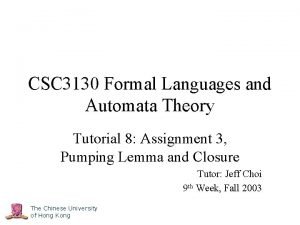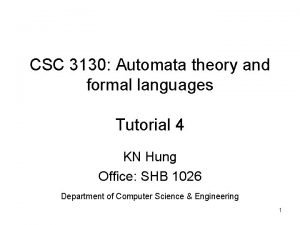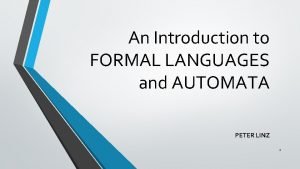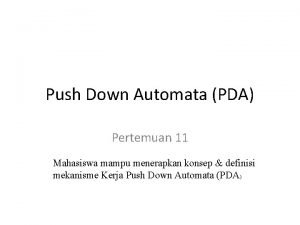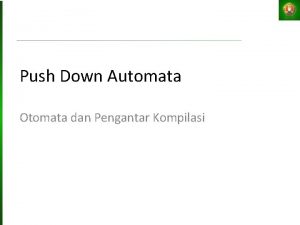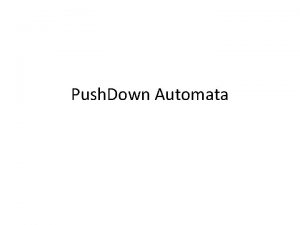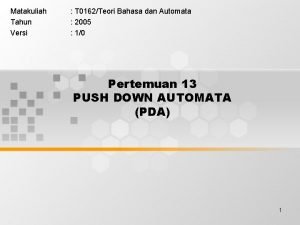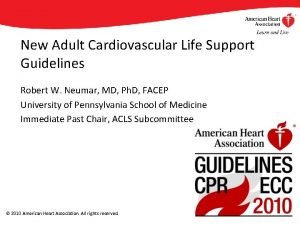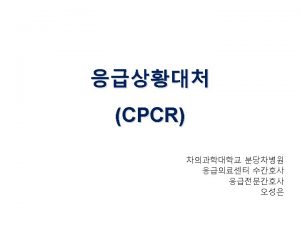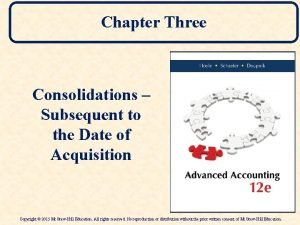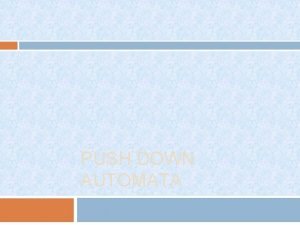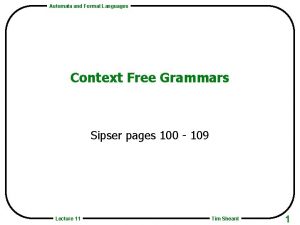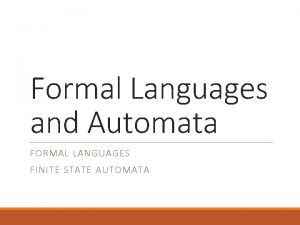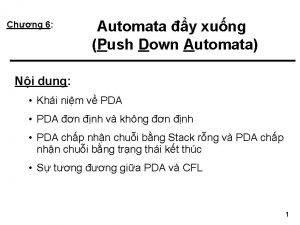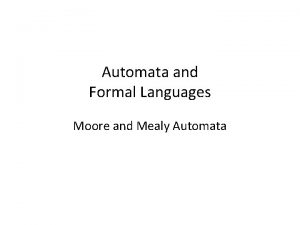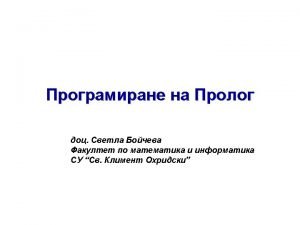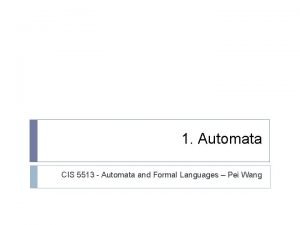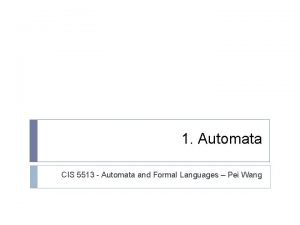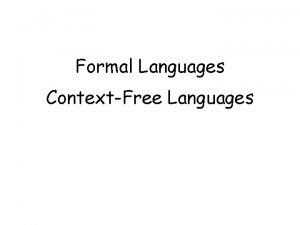Automata and Formal Languages Push Down Automata Sipser

















- Slides: 17

Automata and Formal Languages Push Down Automata Sipser pages 109 - 114 Lecture 13 Tim Sheard 1

Push Down Automata (PDAs) are e-NFAs with stack memory. Transitions are labeled by an input symbol together with a pair of the form X/a. The transition is possible only if the top of the stack contains the symbol X After the transition, the stack is changed by replacing the top symbol X with the string of symbols a. (Pop X, then push symbols of a. )

Example PDAs can accept languages that are not regular. The following one accepts: L={0 i 1 j | 0 £ i £ j} 0, X/XX s 1, Z 0/Z 0 1, X/e 0, Z 0/XZ 0 1, X/e p e, Z 0/Z 0 q

Definition A PDA is a 6 -tuple P=(Q, S, G, d, q 0, F) where Q, S, q 0, F are as in NFAs, and • G is the stack alphabet. It is assumed that initially the stack is empty. • d: Q × Sε × Gε ¾® P(Q × G ε *) is the transition function: given a state, an input symbol (or e), and a stack symbol, Gε, it gives us a finite number of pairs (q, a), where q is the next state and a is the string of stack symbols that will replace X on top of the stack. • Recall Sε =(SÈ{e}) Gε =(GÈ{e})

In our example, the transition from s to s labeled (0, Z 0/XZ 0) corresponds to the fact (s, XZ 0) d(s, 0, Z 0). A complete description of the transition function in this example is given by d(s, 0, Z 0) = {(s, XZ 0)} d(s, 0, X) = {(s, XX)} 0, X/XX d(s, e, Z 0) = {(q, Z 0)} 0, Z /XZ 1, X/e d(s, 1, X) = {(p, e)} 1, X/e e, Z /Z s p d(p, 1, X) = {(p, e)} d(p, e, Z 0) = {(q, Z 0)} e, Z /Z d(q, 1, Z 0) = {(q, Z 0)} and d(q, a, Y)=Æ for all other possibilities. 0 1, Z 0/Z 0 0 0 q

Sipser style acceptance • Suppose a string w can be written: w 1 w 2 … wm • Wi Sε Some of the wi are allowed to be e • I. e. One may write “abc” as aebce • If there exist two sequences • s 0 r 1 … r m Q • s 0 s 1 … s m G* (The si represent the stack contents at step i) 1. r 0=q 0 and s 0 = ε (ri+1, b) d(ri, wi+1, a) 2. si = at 3. Rm F si+1 = bt

Instantaneous Descriptions and Moves of PDAs IDs (also called configurations) describe the execution of a PDA at each instant. An ID is a triple (q, w, a), with this intended meaning: • q is the current state • w is the remaining part of the input • a is the current content of the stack, with top of the stack on the left.

The relation |- describes possible moves from one ID to another during execution of a PDA. If d(q, a, X) contains (p, a), then (q, aw, Xb) |- (p, w, ab) is true for every w and b. The relation |-* is the reflexive-transitive closure of |We have (q, w, a) |-* (q', w', a') when (q, w, a) leads through a sequence (possibly empty) of moves to (q', w', a')

Automata and Formal Languages 0, X/XX s 1, Z 0/Z 0 1, X/e 0, Z 0/XZ 0 1, X/e p L, Z 0/Z 0 q Z 0/Z 0 (s, 011, z) |- (s, 11, xz) |- (P, 1, z)|-(q, 1, z) |- (q, ””, Z) (s, 011, z) |- (q, 011, Z) Lecture 13 Tim Sheard 9

Properties of |Property 1. If Then (q, x, a) |-* (p, y, b) (q, xw, ag) |-* (p, yw, bg) If you only need some prefix of the input (x) and stack (a) to make a series of transitions, you can make the same transitions for any longer input and stack. Property 2. If Then (q, xw, a) |-* (p, yw, b) (q, x, a) |-* (p, y, b) It is ok to remove unused input, since a PDA cannot add input back on once consumed.

Another notion of acceptance A PDA as above accepts the string w iff (q 0, w, ε) |-* (p, e, a) is true for some final state p and some a. (We don't care what's on the stack at the end of input. ) The language L(P) of the PDA P is the set of all strings accepted by P.

Here is the chain of IDs showing that the string 001111 is accepted by our example PDA: |||||||- (s, 001111, ε) (s, 01111, XZ 0) (s, 1111, XXZ 0) (p, 111, XZ 0) (p, 11, Z 0) (q, e, Z 0) 0, X/XX s 1, Z 0/Z 0 1, X/e 0, ε/XZ 0 1, X/e p L, Z 0/Z 0 q

The language of the following PDA is {0 i 1 j | 0 < i £ j}*. How can we prove this? 1, X, e 0, X/XX s 0, Z 0/XZ 0 p L, Z 0/Z 0 1, X/e q

Example A PDA for the language of balanced parentheses: (, Z 0/XZ 0 (, X/XX p ), X/e L, Z 0/Z 0 q

Acceptance by Empty Stack Define N(P) to be the set of all strings w such that (q 0, w, ε) |-* (q, e, e) for some state q. These are the strings P accepts by empty stack. Note that the set of final states plays no role in this definition. Theorem. A language is L(P 1) for some PDA P 1 if and only if it is N(P 2) for some PDA P 2.

Proof 1 1. From empty stack to final state. Given P 2 that accepts by empty stack, get P 1 by adding a new start state and a new final state as in the picture below. We also add a new stack symbol X 0 and make it the start symbol for P 1's stack. P 2 p 0 e, X 0/Z 0 X 0 q 0 e, X 0/e (add this transition from all states of P 2 to new state Pf) Pf

Proof 2 2. From final state to empty stack. Given P 1, we get P 2 again by adding a new start state, final state and start stack symbol. New transitions are seen in the picture. P 2 p 0 e, X 0/Z 0 X 0 q 0 e, G/ e P e, G/ e
 Sipser, m: introduction to the theory of computation
Sipser, m: introduction to the theory of computation Csci 3130
Csci 3130 Formal languages and automata theory tutorial
Formal languages and automata theory tutorial Csc3120 datasheet
Csc3120 datasheet An introduction to formal languages and automata
An introduction to formal languages and automata Formal languages and automata theory tutorial
Formal languages and automata theory tutorial Automata theory tutorial
Automata theory tutorial Pda
Pda Contoh soal push down automata dan jawabannya
Contoh soal push down automata dan jawabannya Pushdown automata visualization
Pushdown automata visualization Push down automata (pda) didefinisikan dengan
Push down automata (pda) didefinisikan dengan Push hard push fast fully recoil
Push hard push fast fully recoil Push hard push fast fully recoil
Push hard push fast fully recoil Push hard push fast fully recoil
Push hard push fast fully recoil Components of high quality cpr
Components of high quality cpr Push hard push fast fully recoil
Push hard push fast fully recoil Asp medical clinic
Asp medical clinic Consolidation entry asterisk c relates to
Consolidation entry asterisk c relates to


